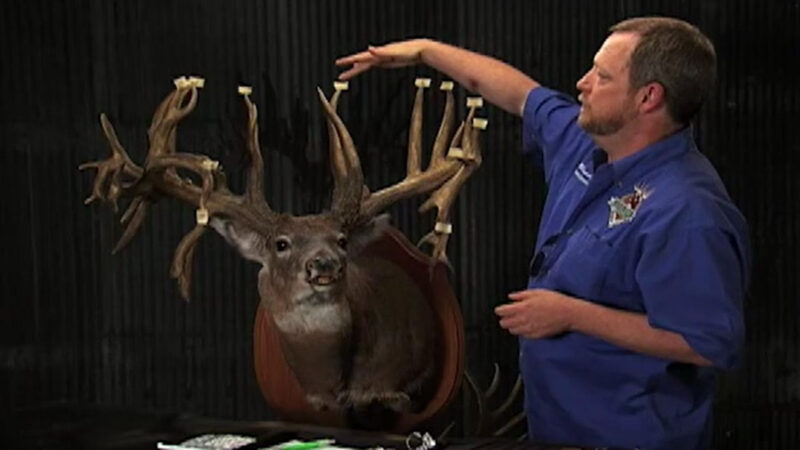Scroll through social media these days and you’ll find a growing trend in the way deer hunters score their deer. More and more hunters are using the Buckmasters scoring system now than ever before – but why?
Why is this scoring system that’s been around for decades becoming more of a standard for how a lot of hunters are putting the numbers to their buck each year?
After all, the Boone & Crocket Club has been formally publishing the scoring of big game animals since the early 1950s and the Pope & Young Club system, designed specifically for archery, began in 1961 when the club was founded.
So why the need for another scoring system? Where did the Buckmasters scoring system come from? Read on for a closer look at the back story on the Buckmasters system and why it’s become so popular among today’s deer hunters.

How It Started
According to the Buckmasters Scorer’s Handbook, the Buckmasters scoring system is based on the method of evaluating white-tailed deer antlers developed by Russell Thornberry, who recognized that other scoring systems’ symmetry-based formulas often were like shaving square pegs to fit into round holes.
Thornberry’s system first appeared in print in “Trophy Deer in Alberta,” published in 1982. Adopted by Buckmasters in the mid-1990s, the Full-Credit Scoring System abandons the punitive pursuit of symmetry and simply gives a rack credit for the full amount of antler present.
According to Buckmasters, Thornberry got the idea after witnessing a hunting partner shoot off a 10-inch drop tine from an otherwise perfectly symmetrical rack simply because the 20-inch deduction (against its typical score) would’ve kept it out of the B&C record book.
Thornberry figured any system that would allow a deer to benefit by actually losing antler seemed silly. He envisioned a better way, a system that would give a buck credit for what it grew in antlers.
Thornberry’s everything-counts, no-deductions philosophy was behind 1982’s “Trophy Deer of Alberta.” It’s a philosophy Buckmasters founder, Jackie Bushman, agreed with and it’s now been the backbone of eight editions of “Buckmasters Whitetail Trophy Records.”
How is the Buckmasters System Different?
It makes sense when you think about all the deductions and drama that often come around some of the high-profile bucks we’ve seen over the years.

The BTR Score includes every inch of antler plus the inside spread. The Inches of Antler measurement is simply the total inches of antler grown. “We use the Inches of Antler measurement to rank bucks for determining records,” says Piper.
Piper admits that going against a system that’s been in place for many years can be tough. People are set in their ways, and their mindset may not allow for something new and different – even if it’s a better, more accurate measurement.
“Unfortunately, people have been so trained to think of a score that includes a spread that we have to bow to convention and include it in our BTR score to provide a more apples-to-apples comparison,” says Piper.

How to Score and Register Your Buck
Want to have your buck scored with the Buckmasters system? No problem. There are scorers in a number of cities in states across the country. Check out the directory link below to find a scorer in your state.

Buckmasters does not charge to measure antlers but does have an entry fee for anyone wanting to enter their buck in the Buckmasters record book.
The entry fee is $25 for all complete racks and $12.50 for single shed antlers.
Items Required for Entry:
Send the completed, double-checked and signed scoresheet, along with photo(s) and a check or money order payable to Buckmasters, to: Buckmasters Whitetail Trophy Records, 10350 Hwy. 80 E, Montgomery, AL 36117.
More and more hunters are learning to appreciate a scoring system that gives credit where credit is due when it comes to the antlers of a white-tailed deer. It’s not about fancy numbers and manipulation. It’s scoring a buck by the bone he grew in that particular year.
It’s a plain and simple approach that was unfortunately overlooked in the earliest days of deer scoring.
What about you? What scoring system will you use on your next buck? Comment below, and let us know what you think.
EDITORS NOTE & UPDATE:
Since I talked to Buckmasters in late 2024, they’ve made some significant changes to the scoring system. Piper told me they now include inside spread in the official score, and there is only one score. “I still believe spread is a measurement of air, but it’s so ingrained in people’s minds that it doesn’t make sense to try to fight it. The spread measurement also provides a key reference for picturing a rack in your head. In the end, this change furthers the Buckmasters mission to simplify scoring and bring it to the regular hunters in a way that makes sense.”

 By
By 



